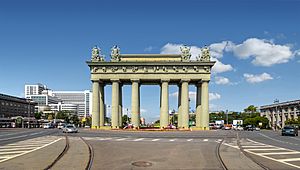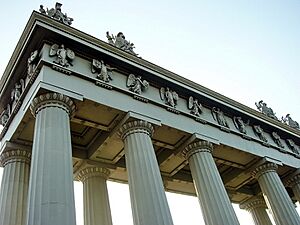Moscow Triumphal Gate facts for kids
The Moscow Triumphal Gate is a huge archway in Saint Petersburg, Russia. It was built between 1834 and 1838. This impressive monument is mostly made of cast iron, a very strong metal. It was built to celebrate Russia's victory in the Russo-Turkish War, 1828-1829.
Contents
Building the Moscow Triumphal Gate
Choosing the Location
At first, the gate was planned for a different spot. It was supposed to be near the Obvodny Canal. But as the city of Saint Petersburg grew south, the location changed. The gate was then built where the Moscow highway (now Moscow Avenue) met the Ligovsky Canal. This made the gate not just a monument, but also a grand entrance to the city.
The Architect and His Vision
The Moscow Triumphal Gate was designed by a Russian architect named Vasily Stasov. He also worked on another famous gate in Saint Petersburg, the Narva Triumphal Gate. Stasov was known for his "Empire style" of architecture. He created several designs for the gate. The final plan was approved in 1834. A sculptor named Boris Orlovsky then made models for the gate's decorations. These included war trophies and figures of "geniuses," which were like spirits or angels.
Iron Giants: How It Was Built
The main material for the gate was cast iron. Many parts were made at local factories. This included the ends of the columns and the walls above the top edge. The detailed sculptures, like the figures of geniuses and trophies, were made from copper sheets. The huge cast iron columns were made at another factory nearby.
Each of the gate's 12 columns was made from nine separate blocks. All the columns together weigh about 450 tons. The first column was put up on July 14, 1836. The entire gate was officially opened two years later, on October 16, 1838. At that time, the Moscow Gate was the largest structure in the world made of cast iron.
A Symbol of Victory
The gate's grand design, with its powerful columns, showed the strength and glory of the Russian army. The sculptures of war trophies, flags, and weapons further highlighted the military victory. An interesting new feature was a band of 30 sculptural figures. These "geniuses" were made from copper sheets. This was seen as a very modern idea for architecture back then. The gate was built to show off the power of the state. This idea was common in many of Stasov's designs in Saint Petersburg.
The Gate in the 20th Century
Moving and Reusing the Gate
In 1936, during the time of Joseph Stalin, the historic gate was taken apart. The plan was to move it to Moscow Square Park. However, this never happened. Later, in 1941, during the Siege of Leningrad, the German army was getting close to the city. The heavy cast iron blocks from the gate were then used. They helped build anti-tank defenses near the city's southern edge. These defenses helped stop the German army during the long siege.
Bringing It Back to Life
After the war, the gate was put back together. This restoration happened from 1958 to 1960. A team of restorers, led by architect Ivan Kaptsyug, worked on it. They managed to rebuild most of the missing sculptures and details. New columns, decorative bands, and top edges were cast at the Kirov factory in Leningrad.



